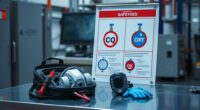Before you start your post-session recovery routine, make certain you hydrate with water or electrolyte drinks to replace fluids lost during exercise. Follow with gentle stretching that targets major worked muscles, holding each stretch for 20-30 seconds. Fuel your body with a balanced snack of protein and carbs to support muscle repair. Incorporate rest or light activities like foam rolling to boost circulation. Keep these steps in mind to optimize recovery—there’s more to explore for best results.
Key Takeaways
- Replenish fluids immediately with water and electrolyte drinks to prevent dehydration.
- Perform gentle stretching on major muscle groups, holding each stretch for 20-30 seconds.
- Incorporate static stretches after workouts to improve flexibility and reduce muscle tension.
- Consume a balanced post-workout meal with protein and carbohydrates to support muscle repair.
- Allow adequate rest and consider foam rolling or light activity to promote recovery and reduce soreness.
Post-Workout Recovery Tips

After a tough workout, prioritizing your recovery is essential for ideal progress and injury prevention. One of the most effective ways to do this is by focusing on hydration strategies. Proper hydration helps replenish fluids lost through sweat, supports muscle repair, and keeps your energy levels stable. Drinking water immediately after your session is crucial, but don’t forget to include electrolyte-rich drinks if your workout was particularly intense or prolonged. Electrolytes like sodium, potassium, and magnesium play a vital role in maintaining fluid balance and preventing cramps. Keep a water bottle handy during your workout, and make it a habit to sip small amounts regularly afterward. This ensures your body rehydrates steadily, avoiding dehydration that can slow recovery and increase soreness.
Along with hydration, paying attention to stretching techniques can significantly enhance your recovery process. Gentle stretching helps relax tight muscles, improve flexibility, and reduce the risk of stiffness later on. Focus on stretching major muscle groups you worked during your session, holding each stretch for about 20-30 seconds without bouncing. Incorporate dynamic stretches immediately after your workout to cool down and static stretches afterward to lengthen muscles and promote circulation. Proper stretching not only alleviates muscle tension but also encourages blood flow, which brings nutrients and oxygen to fatigued tissues, speeding up repair. It’s important to listen to your body during stretching—avoid forcing movements that cause pain or discomfort.
Additionally, understanding muscle recovery can help you tailor your routines for better results. To maximize the benefits, combine your stretching techniques with proper hydration. Drinking water before, during, and after stretching helps keep your muscles pliable and reduces the risk of cramps. Also, consider adding a post-workout nutrition plan that includes protein and carbohydrates to support muscle repair and replenish glycogen stores. Rest is another critical component; giving your muscles time to recover prevents overtraining and reduces injury risk. Incorporate light activity or foam rolling as part of your routine to further loosen tight muscles and improve circulation.
Frequently Asked Questions
How Long Should I Rest After a Workout Before Recovery?
You should rest for about 10 to 30 minutes after a workout before starting your recovery routines. This rest duration allows your body to cool down and reduces muscle soreness. Recovery timing varies depending on workout intensity and your fitness level, but listening to your body is key. If you’re feeling fatigued, extend your rest period. Proper recovery guarantees your muscles heal and prepares you for future sessions.
Can I Skip Stretching During Post-Session Recovery?
Skipping stretching during post-session recovery is like leaving a puzzle incomplete—you miss essential pieces. Dynamic stretching and muscle relaxation help release tension and improve flexibility, aiding your muscles in returning to their natural state. While it’s tempting to skip, embracing these routines prevents stiffness and promotes quicker recovery. You’ll find your muscles thank you, feeling less tight and more prepared for your next challenge.
What Are Signs of Overtraining During Recovery?
If you notice persistent muscle soreness, fatigue, or irritability, these could be signs of overtraining during recovery. Hormonal imbalances might cause decreased performance and mood swings, signaling your body needs more rest. You may also experience trouble sleeping or a weakened immune system. Pay attention to these signs, reduce intensity, and prioritize recovery to prevent burnout and promote proper healing.
Is Foam Rolling Necessary for Every Workout?
Foam rolling isn’t necessary after every workout, but it can be beneficial. It complements your stretching routines, helping release muscle tension and improve flexibility. If you experience tightness or soreness, incorporating foam rolling or massage therapy can enhance recovery. However, listen to your body—if you feel fine, skip it. Consistency with stretching routines and occasional foam rolling will support your overall progress without making them mandatory after every session.
How Does Hydration Impact Recovery Speed?
Hydration markedly impacts your recovery speed by maintaining electrolyte balance and promoting muscle rehydration. When you drink enough fluids, your muscles recover faster, soreness decreases, and energy levels boost. Proper hydration also prevents cramps and fatigue, allowing you to bounce back quicker. Make sure to replenish lost electrolytes through drinks or foods, as this helps optimize muscle function and speeds up your overall recovery process after workouts.
Conclusion
As you finish your session, picture your muscles gently cooling down like waves settling after a storm. Embrace the calm as you hydrate and stretch, letting your body soak in the recovery process. Imagine each routine as a nurturing hug, helping your muscles repair and strengthen. With these simple steps, you’re not just ending a workout—you’re planting seeds for your next challenge. Rest well, recover fully, and get ready to conquer again tomorrow.









